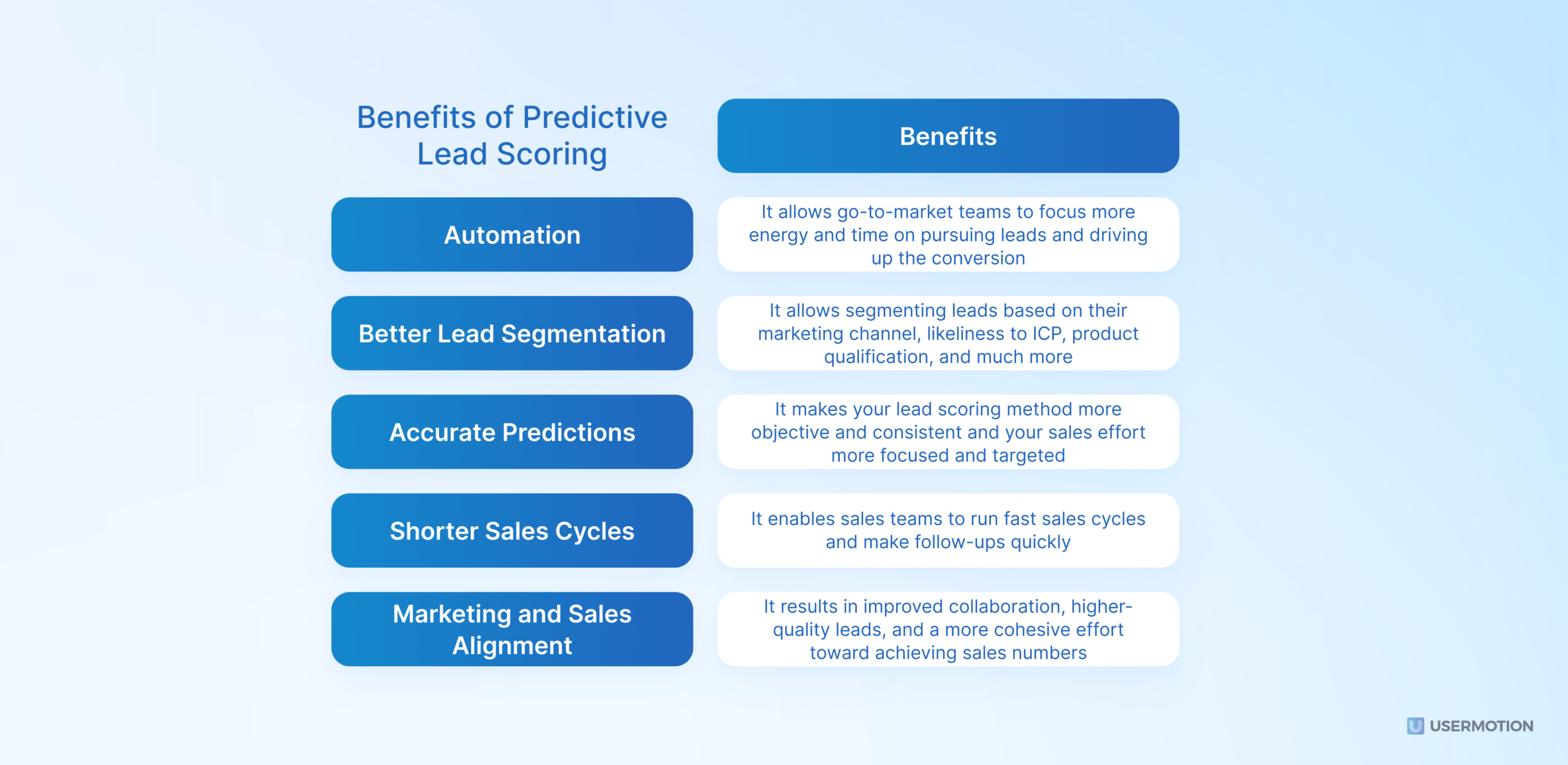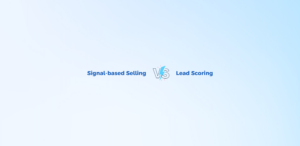You know what’s worse than having no leads at all? Collecting too many leads and then struggling to narrow them down to a few accounts that you can reach out to and convert.
It’s always better to reach out to high-intent, product-qualified leads who are further ahead in their buyer’s journey. That way, your sales team can make real progress.
TL;DR
- Predictive scoring eliminates manual sorting, saves time, and enhances accuracy.
- In B2B sales, the process involves data collection, modeling, scoring, and integration, resulting in improved efficiency and collaboration between marketing and sales teams.
- The multifaceted benefits of predictive lead scoring include automation, enhanced lead segmentation, prediction accuracy, shortened sales cycles, and marketing and sales alignment.
- UserMotion’s tool prioritizes high-quality leads through predictive scoring, offering automation, enhanced segmentation, accurate predictions, shortened sales cycles, and improved marketing and sales alignment.
What is Predictive Lead Scoring?
Predictive lead scoring uses data analytics and machine learning algorithms to evaluate the quality of leads based on your Ideal Customer Persona (ICP), the behavioral data, and recent conversions.
Through data-backed assessment, the leads are ranked based on:
- The actions that the leads have taken
- The way they’ve interacted with your funnel
- How well they match to your Ideal Customer Persona (ICP)
Predictive lead scoring software integrates within your marketing and sales channels. Through the integration, it:
- Builds a trackable metric system that absorbs the data of existing customers to rank prospects
- Allows the sales team to target and work with high-quality leads
- Gives direct feedback about the marketing channels based on the average high-quality lead generation
- Optimizes resource allocation and maximizes ROI
- Improves the conversion rate and customer retention
Traditional vs. Predictive Lead Scoring Models
Lead scoring is a dated concept, and the prioritization of one lead over the other has existed since the inception of commerce. Customers more likely to make a purchase are wooed and chased a bit harder than those who are less of a fit for the ideal customer persona (ICP).
In traditional lead scoring, marketers have the liberty of ranking leads based on set criteria, such as
- Email list response
- eBook and marketing flier downloads
- Social media engagement
- Repeat website visits
It’s a good enough process that has narrowed down leads and generated tremendous business in the past. But at the end of the day, this process is manual and prone to error.
Predictive lead scoring models automate the scoring and ranking process and limit the chances of errors.
Take UserMotion’s sales intelligence tool, for example. UserMotion creates an ideal customer profile (ICP) based on the existing customers, recent conversions, and past sales cycles. This ICP is used as a model to rank incoming leads.
The closer a lead is to your ICP, the higher it will be ranked by UserMotion.
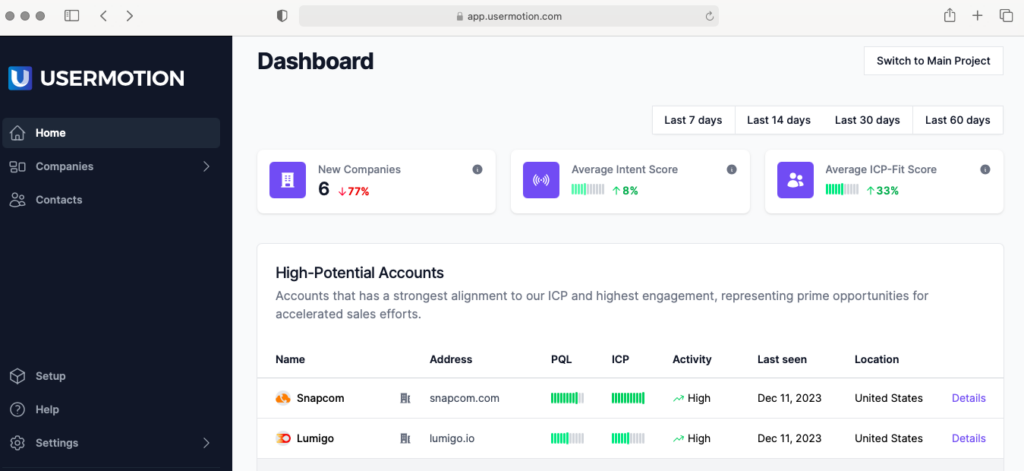
In traditional lead scoring, the ICP is based on whatever metrics can be best accessed by the marketing and sales team. These metrics risk being outdated, rigid, and often inconsistent with how the leads must be evaluated to fit the current sales cycle.
On the other hand, UserMotion’s predictive lead scoring is dynamic; it continues to evolve with data based on recent lead conversions.
Related: Close More Deals With Predictive Lead Scoring
B2B Sales With Predictive Lead Scoring
B2B sales stands to benefit greatly from predictive lead scoring. From automating lead scoring to streamlining the sales process, predictive lead scoring and sales intelligence improve the overall efficiency and functioning of B2B marketing and sales teams.
Here’s what the process entails:
Step 1. Data Collection: Data is gathered from CRM systems, data enrichment sources, and product usage systems to give the lead scoring tool holistic information about lead behavior, ICP, recent conversions, and existing customers.
Step 2. Modeling: Key variables indicative of lead quality and conversion potential are identified. These variables often include demographic and firmographic information, engagement history, website interaction, collateral downloads, and other relevant data points.
Step 3. Scoring: The trained model scans and scores leads based on their likelihood of conversion. Each lead receives a predictive score, which indicates its potential value and priority status on the ladder. The higher the score, the more likely the lead is to convert.
Step 4. Integration: The scoring model is integrated within your CRM so the sales team can directly access freshly rated leads. Additionally, the marketing team can study the dashboard and get timely updates on the efficiency of lead-generating channels.
5 Benefits of Predictive Lead Scoring
Predictive lead scoring uses data analysis and predictive analytics to assign scores to leads. The evaluation of leads is based on their likelihood of conversion.
We’ve discussed the features of predictive lead scoring. Now, here are the top five benefits of predictive lead scoring.
1. Automation
As we discussed above, traditional lead scoring is manual, whereas predictive lead scoring is completely automated. From the moment a lead interacts with your website or funnel to when it’s served to the sales rep, the entire process happens in the background, 24/7. This automation, which includes a thorough lead analysis, allows go-to-market teams to focus more energy and time on pursuing leads and driving up the conversion.
2. Enhanced Lead Segmentation
Predictive lead scoring doesn’t just let you know what your top leads of the day are; it also segments them based on their marketing channel, likeliness to ICP, product qualification, and much more.
For example, check out UserMotion’s lead segmentation:
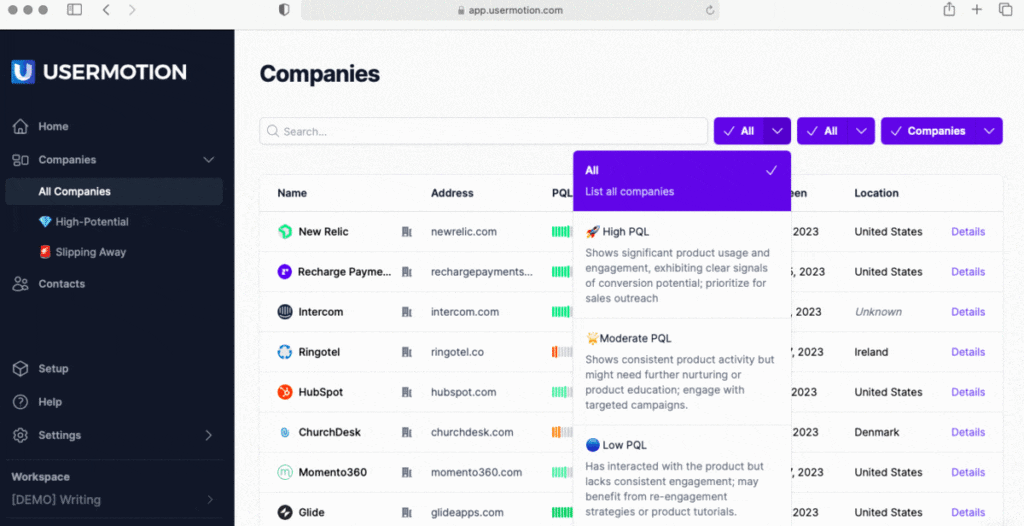
This kind of segmentation helps in creating targeted and personalized marketing campaigns that are more likely to resonate with specific groups of leads.
3. Accurate Predictions
Predictive lead scoring eliminates bias, guesswork, and subjective judgment by relying on data-driven predictions, existing customer profiles, and recent conversion cycles. You’re no longer throwing darts in the dark, hoping for that lucky strike.
With lead scoring, you put your entire lead qualification process on autopilot, running on a self-learning and constantly evolving engine. This makes your lead scoring method more objective and consistent and your sales effort more focused and targeted.
4. Shortened Sales Cycles
The traditional lead scoring model is a real time-eater. Instead of sales reps slogging through each potential lead while burning through time and resources, predictive lead scoring allows them to focus on leads with higher scores. This often means dealing with leads further along in the buying process, resulting in shorter sales cycles as the leads are more likely to move through the sales funnel more quickly.
In the age of heavy competition and cheap alternatives, speed and timing are of the essence. It matters how quickly your sales teams are capitalizing on opportunities.
The instant classification of leads by predictive lead-scoring algorithms enables sales representatives to initiate follow-ups quickly.
5. Marketing and Sales Alignment
In this complicated world of digital marketing, it often feels like marketing and sales teams are operating in different universes rather than collaborating side by side.
Take, for instance, your marketing team. They put their blood, sweat, and expertise into generating leads. But they are often removed from the process of lead conversion.
And then there’s your sales team, hungry for more leads to run up their closing numbers, regardless of where they’re coming from. Predictive lead scoring provides a standardized and unbiased definition of qualified leads, which optimizes the sales and marketing teams in their individual and collaborative capacities.
This alignment results in improved collaboration, higher-quality leads, and a more cohesive effort toward achieving sales numbers.
How UserMotion Prioritizes High-Quality Leads With Predictive Lead Scoring?

UserMotion’s plug-and-play sales intelligence tool integrates with your systems and collects all your leads in a centralized dashboard.
The high-potential accounts are ranked based on their activity, intent score, product qualification, and ICP score.
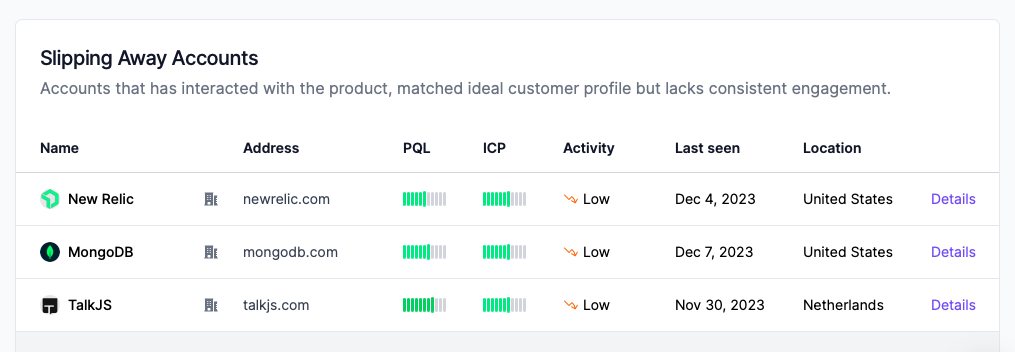
It also shows leads slipping away, so your sales team can be proactive and nurture accounts with diminishing user activity.
What’s more? UserMotion integrates with your tech ecosystem and handles the data repositories, contact details, and payment gateways for all your leads.
Now, that’s an excellent CRM system for all your contacts. Just click on ‘details’ and get started.
UserMotion’s unique CRM and sales intelligence systems put you miles ahead in the sales process. Snag your spot in our free trial today!
FAQs
1. What is predictive lead scoring?
Predictive lead scoring is a data-driven method that uses analytics and machine learning to evaluate lead quality based on the likelihood of conversion. Unlike traditional lead scoring, predictive scoring automates the process, reduces errors, and adapts dynamically to recent lead conversion data.
2. How does predictive lead scoring benefit B2B sales teams?
Predictive lead scoring offers several benefits for B2B sales, including automated lead ranking, enhanced lead segmentation, accurate predictions, shortened sales cycles, and improved alignment between marketing and sales teams. It optimizes resource allocation, maximizes ROI, and contributes to better overall efficiency.
3. How does predictive lead scoring work in B2B sales?
The implementation involves data collection from CRM systems and other sources, modeling key variables, scoring leads based on conversion likelihood, and integrating the scoring model into CRM systems. This process streamlines lead prioritization, providing sales teams with valuable insights and boosting overall efficiency.
4. How does UserMotion prioritize high-quality leads using predictive lead scoring?
UserMotion’s tool collects leads, ranks them based on behavior like webpage visits and demo engagement, and integrates with your tech ecosystem for a seamless CRM system. The tool combines expert-made lead signals with your company’s Ideal Customer Profile (ICP) signals, ensuring a prioritized list of high-quality leads.
5. How does predictive lead scoring address the challenges of bias and manual errors in lead scoring?
Predictive lead scoring eliminates bias and manual errors by relying on data-driven predictions and machine-learning algorithms. It ensures objectivity and consistency in lead qualification, as the model evolves with recent conversion data, reducing the risk of outdated or inconsistent metrics seen in traditional lead scoring methods.

